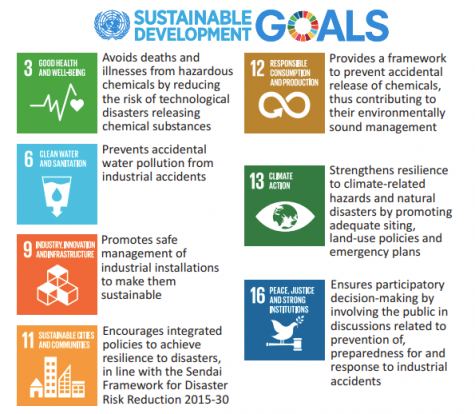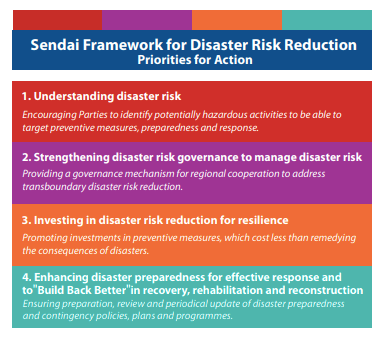 |
 |
2030 Agenda for Sustainable Development
Societies can only prosper on a solid foundation of security and stability, which can be wiped away in minutes as a consequence of both natural and technological disasters. Sustainable development in its economic, environmental and social dimensions relies on the solid management of disaster risks. This is because disasters exacerbate poverty, disproportionately affecting the most vulnerable, who often live in exposed areas such as informal settlements constructed with little or no regard to building codes. Disasters can also have a devastating impact upon fragile ecosystems, destroy schools and hospitals affecting health and educational outcomes, and result in increased social tensions and weakened institutional support systems for social policy.
The UNECE Conventions, frameworks and tools help countries to reduce and manage disaster risks and enhance resilience, thereby contributing to the attainment of the 2030 Agenda for Sustainable Development, including its Sustainable Development Goals and the Sendai Framework for Disaster Risk Reduction 2015-2030.
The good practices and lessons learned presented in this Information Repository highlight those countries leading the way to achieving:
SDG11 – Sustainable Cities and Communities:
Covering integrated issues of land-use planning/siting, industrial safety, environmental assessment, public participation and information to the public, and disaster risk reduction, the case studies presented in the Information Repository highlight the efforts by UNECE countries to make cities and human settlements inclusive, safe, resilient and sustainable. They also encourage integrated policies to achieve resilience to disasters, in line with the Sendai Framework for Disaster Risk Reduction 2015-30.
In particular, the case studies represent countries’ efforts in meeting the following targets:
- Target 11.3: By enhancing inclusive and sustainable urbanization and capacity for participatory, integrated and sustainable human settlement planning and management in all countries
- Target 11.4: By strengthening efforts to protect and safeguard the world’s cultural and natural heritage
- Target 11.5: By significantly reducing the number of deaths and the number of people affected and by substantially decreasing the direct economic losses relative to global gross domestic product caused by disasters
- Target 11.b: By substantially increasing the number of cities and human settlements adopting and implementing integrated policies and plans towards inclusion, resource efficiency, mitigation and adaptation to climate change, resilience to disasters, and by developing and implementing, in line with the Sendai Framework for Disaster Risk Reduction 2015-2030, holistic disaster risk management at all levels
The case studies also highlight efforts to achieve other SDGs, such as:
SDG 3 – Good Health and Wellbeing, by avoiding deaths and illnesses from hazardous chemicals by reducing the risk of technological disasters releasing chemical substances
SDG 9 – Industry, Innovation and Infrastructure, by promoting the safe siting and management of industrial installations to make them sustainable
SDG 12 – Responsible Consumption and Production, by providing a framework to prevent the accidental release of chemicals, thus contributing to their environmentally sound management
SDG 13 – Climate Action, by strengthening resilience to climate-related hazards and natural disasters by promoting adequate siting, land-use policies and emergency plans
SDG 16 – Peace, Justice and Strong Institutions, by ensuring participatory decision-making by involving the public in discussions related to industrial safety and land-use planning/siting
The Sendai Framework for Disaster Risk Reduction:
The good practices and lessons learned presented in the Information Repository are important examples of how UNECE countries are working towards the implementation of the Sendai Framework for Disaster Risk Reduction 2015 – 2030.
The case studies highlight how land-use planning, siting and industrial safety legislation, policies and measures can reduce the exposure and vulnerabilities of populations and the environment with respect to an identified hazard and related risk. This corresponds to the Sendai Framework’s 4 Priorities for Action, as follows:
1. Understanding disaster risk: by identifying potentially hazardous industrial activities to be able to target preventive measures, preparedness and response.
2. Strengthening disaster risk governance to manage disaster risk: by providing governance mechanisms for local, national and regional (including transboundary) cooperation to address disaster risk reduction.
3. Investing in disaster risk reduction for resilience: by promoting investments in preventive measures, which cost less than remedying the consequences of disasters.
4. Enhancing disaster preparedness for effective response and to "Build Back Better" in recovery, rehabilitation and reconstruction: by ensuring the preparation of policies, plans, programmes and/or measures for disaster preparedness and the active involvement of the public, industry, various levels of government and other key stakeholders in the process.

